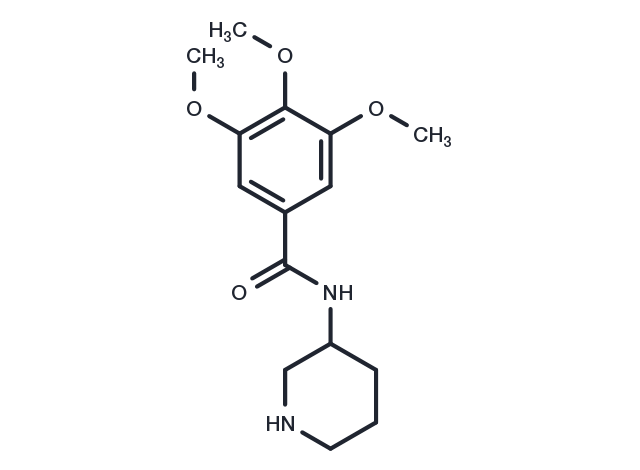Powder: -20°C for 3 years | In solvent: -80°C for 1 year


Troxipide (Aplace), a new-type systemic non-antisecretory gastric cytoprotective agent, which is mucus-secreting, anti-ulcer, and anti-inflammatory properties irrespective of pH of stomach or duodenum.

| Pack Size | Availability | Price/USD | Quantity |
|---|---|---|---|
| 100 mg | In stock | $ 50.00 | |
| 1 mL * 10 mM (in DMSO) | In stock | $ 50.00 |



| Description | Troxipide (Aplace), a new-type systemic non-antisecretory gastric cytoprotective agent, which is mucus-secreting, anti-ulcer, and anti-inflammatory properties irrespective of pH of stomach or duodenum. |
| In vitro | Troxipide is a new-type anti-ulcer compound that has an inhibitory effect on human neutrophil migration and has various agonist-induced activation. It inhibits neutrophil-mediated inflammation and oxidative stress but does not improve gastric mucus composition and output. In addition, it can increase the secretion of the prostaglandin, a cytoprotective agent. |
| In vivo | Gastric mucosal metabolism and blood flow will be enhanced by Troxipide. |
| Kinase Assay | Surface Plasmon Resonance (SPR) studies: The binding experiments are carried out on a ProteOn XPR36 biosensor at 25°C using the HTE sensor chip. The flow cells of the sensor chip are loaded with a nickel solution at 30 μL/min for 120 s to saturate the Tris–NTA surface with Ni(II) ions. Purified His-tagged STAT3 and STAT5 in PBST buffer (PBS with 0.005% (v/v) Tween-20 and 0.001% DMSO pH 7.4) is injected in the first and second channels of the chip respectively in the vertical direction at a flow rate of 25 μg/μL for 300 s, which attained, on average, ~8000 resonance unit (RU). After a wash with PBST buffer, inhibitors binding to the immobilized proteins is monitored by injecting a range of concentrations along with a blank at a flow rate of 100 μL/min for 200 s for each of these small molecules. When the injection of the small molecule inhibitor is completed, running buffer is allowed to flow over the immobilized substrates for the non-specifically bound inhibitors to dissociate for 600 s. Following dissociation of the inhibitors, the chip surface is regenerated with an injection of 1 M NaCl at a flow rate of 100 μL/ml for 18 s. Interspot channel reference is used for non-specific binding corrections and the blank channel used with each analyte injection served as a double reference to correct for possible baseline drift. Data are analyzed using ProteOn Manager Software version 3.1. The Langmuir 1:1 binding model was used to determine the KD values. |
| Synonyms | Aplace |
| Molecular Weight | 294.35 |
| Formula | C15H22N2O4 |
| CAS No. | 30751-05-4 |
Powder: -20°C for 3 years | In solvent: -80°C for 1 year
DMSO: 15 mg/mL (51 mM)
Ethanol: 3 mg/mL (10.19 mM)
H2O: < 1 mg/mL (insoluble or slightly soluble)
You can also refer to dose conversion for different animals. More
bottom
Please see Inhibitor Handling Instructions for more frequently ask questions. Topics include: how to prepare stock solutions, how to store products, and cautions on cell-based assays & animal experiments, etc.
Troxipide 30751-05-4 Others factor Inhibitor gastritis inhibit orally defensive ulcer antiulcer Aplace gastric inhibitor
